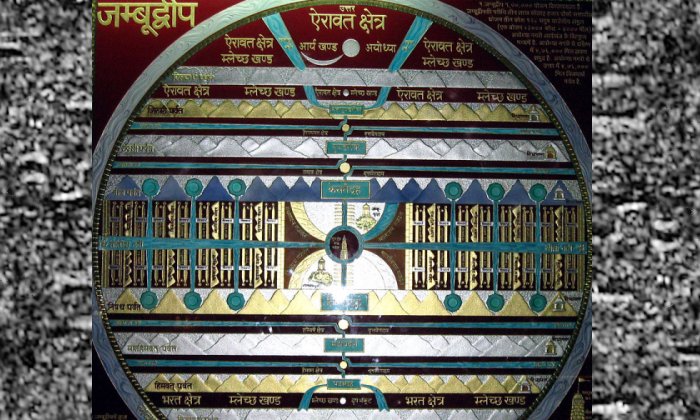A. Sutherland - AncientPages.com - Many forests of fabulous fame have been mentioned in books and described in classical writings.
Myths and legends say that Jambudvipa is one of the four continents, situated south of Mount Kailash (Mount Meru in Buddhist texts), a mountain square with four sides, more prominent at the top than the top at the bottom.

"In the district of Himalaya, there stands the sacred mountain Kailash from which the waters of our world (the Indian subcontinent) flow down. There, on the shore of lake Anavatapta ("never warm") now identified with Manasarovar), stands the sacred Jambu tree from which our world derives its ancient name of Jambudvipa, "the isle of Jambu". Mong the twenty-four places, Mount Kailash is possibly the most famous of all, a favored destination of pilgrims from every school. Known among Hindus as the sacred abode of Shiva, this mountain has been the site of countless legends and miraculous events as recorded in the guidebooks of Buddhist and non-Buddhists alike...´" 1
Jambudvipa - of trapezoidal shape or resembling the shape of an ax-head - is inhabited by rakshasa demons. The southernmost of the four great continents of traditional Buddhist mythology is referred to as the island of the Jambu tree corresponding to the known world at the time. Most probably, it was identified with the Indian subcontinent and south-east Asia. All the other island continents are inhabited by human beings of different characteristics, lifestyles, and lifespans.
The cosmologies of Hinduism, Buddhism, and Jainism refer to the so-called 'jambudvipa,' which means "the land of Jambu trees." The Jambu tree, from which the continent takes its name, is a vast tree believed to be located in the Himalayan region.
According to tradition, Buddhas arise only on this continent, along with the so-called Universal Rulers (chakravartin). The latter represent ideal kings, who are divinely predestined to restore temporal dharma, a concept of the religious and moral law governing individual conduct. It is also one of the four ends of life.
The universe, according to Jainism, has the shape of a triangle surmounted by a hexagon. Between the two exists the Madhya-Loka where the Jambudvipa continent is located. Credit: Shree Diwakar Prakashan - Public Domain
The chakravartin has enormous power and rules over the entire earth, based on the concept dated to the times of the Maurya Empire (322 BC – 184 BC), an wide-ranging, Iron Age historical power of South Asia, founded by Chandragupta Maurya. In the sacred Puranas (in Sanskrit: "ancient, old"), chakravartin appears at certain essential moments in the cosmic cycle, and even different rulers related to historical time used to claim the title of a chakravartin.
However, "a future chakravartin is said to be born with a long list of auspicious and infallible signs, such as webbed fingers and chakras (1) on the palms of his hands, all of which are supposed to denote physical and spiritual perfection. For the Buddhists and Jains, the chakravartin is the temporal equivalent of a Buddha or a Tirthankara," 2, a savior and spiritual teacher of the dharma (righteous path).
Hindu beliefs tell of a vast cosmogonic forest full of the most remarkable flowers and plants. There is a field of flowers of light and a sacred plant of immortality in this celestial realm. From this plant, Dhanvantari - the divine physician of the gods, regarded as an incarnation of Lord Vishnu, the God of protection and sustenance - extracts the divine ambrosia.
Another sacred plant in the forest is the earlier mentioned mighty Jambu tree, which bears an immortal fruit as large as an elephant, resembling gold, and of which the seeds produce pure gold.
According to Buddhism's religious tradition, ordinary human beings represent one of the six classes of beings that live on any of four continents. The tradition continues that beings on each of these four continents remain unseen from each other and have to some extent different physical characteristics and lifespans.
It could suggest the shape of the coastline of southern India, which according to Indian Buddhists, has always been called Jambudvipa, extending 10,000 yojanas (one yojana is about 12–15 km) in extent or has a perimeter of 6,000 yojanas) to which can be added the southern coast of only 3 and 1/2 yojanas' length.
The continent takes its name from a giant evergreen Jambu tree, which grows in the middle of every continent. According to modern sources, the tree can reach up to 30 meters (98 ft) and live more than 100 years. Some assume the Jambu tree to be the rose-apple tree, as it was recently suggested, a plum tree.
However, another version of the Jambu tree story refers to the existence of only one Jambu tree. This tree is not visible to ordinary people but only to enlightened beings.
Written by - A. Sutherland - AncientPages.com Senior Staff Writer
Copyright © AncientPages.com All rights reserved. This material may not be published, broadcast, rewritten or redistributed in whole or part without the express written permission of AncientPages.com
Expand for references- Holm J, Bowker J., Sacred Place
2. W. J. Johnson, A Dictionary of Hinduism
Damien Keown, A Dictionary of Buddhism
Tibetan Buddhist Encyclopedia






